What do you eat? Who do you pray to? How do you dispose of your dead? Looking back on the three books I’ve written so far in the Thrones & Bones series (Frostborn, Nightborn, and the just-finished third manuscript), I shouldn’t be surprised to see that I address these questions in each of the narratives. They appear to be staples of the way I world-build. But that second one—who do you pray to?—is really interesting. I put in a lot of work hammering out the pantheon of deities for each of my imaginary countries, but very little of it shows up in the finished product. A god of luck makes a minor intervention in Frostborn. A god is said to be responsible for a supernatural incident that is related to but not witnessed by the leads in Nightborn. In book three—well, no spoilers, but book three has a strong Grecian influence, and so divine beings may be a little more active than in the previous books.
When I look back at the books that I’ve loved over the years, I see that a lot of them deal with gods and goddesses as very large participants in their world, practically characters in their own right. Here are five books that have made a particularly strong impact on me and the way I think of the divine in fantasy fiction.
Elric: To Rescue Tanelorn by Michael Moorcock
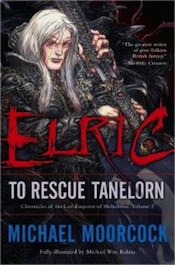 One of my first fantasy loves was Michael Moorcock. I encountered his Eternal Champion series early on and never got over it. That moment when a young Elric of Melniboné summons Duke Arioch, Lord of the Seven Darks, is absolutely chilling. If memory serves, the god appears first as a fly, then as a beautiful male youth who drips power and seduction. The Elric series was the first time I encountered gods who actively participated in their stories, the way the gods and goddesses of Greek mythology did. But there was a specific story, the novella “The Singing Citadel” (which I encountered in the collection/fix-up novel The Weird of the White Wolf, and which appears most recently in Elric: To Rescue Tanelorn), that has never left me. The minor god Balo, Jester to the Court of Chaos, is up to no good, and after battling the god ineffectually, a desperate Elric summons Arioch to deal with him. Arioch crushes Balo’s head, then wads the god up into a ball and swallows him. He tells Elric, “I have not eaten him… It is merely the easiest way of transporting him back to the realms from which he came. He has transgressed and will be punished.” I was both disturbed and fascinated by that scene, which haunted me for years, but it set my young brain puzzling. I realized then that gods were not made of the same mortal clay as we humans and did not have to abide by our rules. And speaking of rules…
One of my first fantasy loves was Michael Moorcock. I encountered his Eternal Champion series early on and never got over it. That moment when a young Elric of Melniboné summons Duke Arioch, Lord of the Seven Darks, is absolutely chilling. If memory serves, the god appears first as a fly, then as a beautiful male youth who drips power and seduction. The Elric series was the first time I encountered gods who actively participated in their stories, the way the gods and goddesses of Greek mythology did. But there was a specific story, the novella “The Singing Citadel” (which I encountered in the collection/fix-up novel The Weird of the White Wolf, and which appears most recently in Elric: To Rescue Tanelorn), that has never left me. The minor god Balo, Jester to the Court of Chaos, is up to no good, and after battling the god ineffectually, a desperate Elric summons Arioch to deal with him. Arioch crushes Balo’s head, then wads the god up into a ball and swallows him. He tells Elric, “I have not eaten him… It is merely the easiest way of transporting him back to the realms from which he came. He has transgressed and will be punished.” I was both disturbed and fascinated by that scene, which haunted me for years, but it set my young brain puzzling. I realized then that gods were not made of the same mortal clay as we humans and did not have to abide by our rules. And speaking of rules…
Deities & Demigods by James M. Ward and Robert J. Kuntz
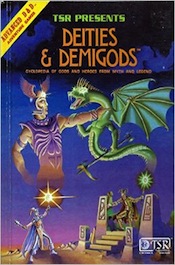 I’m cheating a little by including a rules supplement for first edition Advanced Dungeons & Dragons, but the 1980 Deities & Demigods from TSR made an enormous impact on my imagination. The first two printings included not only gods and demigods from real world mythology and TSR’s proprietary world of Greyhawk, but also stats for Arthurian characters, Fritz Leiber’s Nehwon setting, H. P. Lovecraft’s Cthulhu mythos, and the aforementioned Elric tales of Michael Moorcock. I was already a huge fan of Leiber and Moorcock, and this sent me off to read Lovecraft as well. Something about seeing all these gods, both “real” and fictitious, all alphabetized and statted out for a Game Master’s use was like a crash course in fantasy world-building and comparative religion. Better still, it encouraged ideas for how gods could be included in game scenarios of my own creation (and by extension my fictions). Later editions had to strip out the Leiber, Lovecraft, and Moorcock, as other gaming companies held those licenses, but I still have my original manual!
I’m cheating a little by including a rules supplement for first edition Advanced Dungeons & Dragons, but the 1980 Deities & Demigods from TSR made an enormous impact on my imagination. The first two printings included not only gods and demigods from real world mythology and TSR’s proprietary world of Greyhawk, but also stats for Arthurian characters, Fritz Leiber’s Nehwon setting, H. P. Lovecraft’s Cthulhu mythos, and the aforementioned Elric tales of Michael Moorcock. I was already a huge fan of Leiber and Moorcock, and this sent me off to read Lovecraft as well. Something about seeing all these gods, both “real” and fictitious, all alphabetized and statted out for a Game Master’s use was like a crash course in fantasy world-building and comparative religion. Better still, it encouraged ideas for how gods could be included in game scenarios of my own creation (and by extension my fictions). Later editions had to strip out the Leiber, Lovecraft, and Moorcock, as other gaming companies held those licenses, but I still have my original manual!
Wrath-Bearing Tree (A Tournament of Shadows #2) by James Enge
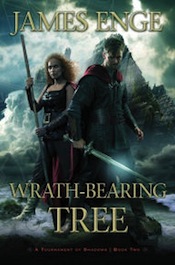 James Enge’s Morlock Ambrosius is one of my all-time favorite fantasy characters, up there with Elric, Fafhrd, the Gray Mouser, and Avatar Korra. Enge take the staples of the fantasy tradition and subverts them delightfully, without ever thumbing his nose at the tropes or being embarrassed to be unabashedly genre. It’s no surprise that he should do this with the gods and goddesses of his world of Laent as well. Nowhere is this more apparent than in Wrath-Bearing Tree, in which Morlock and his future wife, in between bouts of exploring each other sexually (this is no children’s book), are confronted with a host of small (and ill-made) gods produced when mortals ascend something called the Apotheosis Wheel and are transmogrified—often with horrifying results.
James Enge’s Morlock Ambrosius is one of my all-time favorite fantasy characters, up there with Elric, Fafhrd, the Gray Mouser, and Avatar Korra. Enge take the staples of the fantasy tradition and subverts them delightfully, without ever thumbing his nose at the tropes or being embarrassed to be unabashedly genre. It’s no surprise that he should do this with the gods and goddesses of his world of Laent as well. Nowhere is this more apparent than in Wrath-Bearing Tree, in which Morlock and his future wife, in between bouts of exploring each other sexually (this is no children’s book), are confronted with a host of small (and ill-made) gods produced when mortals ascend something called the Apotheosis Wheel and are transmogrified—often with horrifying results.
The Grave Thief (The Twilight Reign #3) by Tom Lloyd
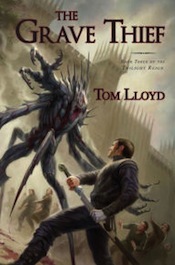 In Tom Lloyd’s Twilight Reign series, gods and goddesses can actually subsume each other and bind these defeated deities into serving as “aspects” of themselves. So the god of Death, for instance, controls multiple aspects like “Disease,” “the Burning Man,” etc. And some of these aspects would rather cast off the yoke and be the one driving the bus, so they scheme to accrue followers and seize the big chair. But in book three in the series, The Grave Thief, things get really interesting! Spoiler alert: The goddess of luck makes an unprecedented decision to choose a human as one of her aspects and then gets herself killed, leaving a human woman as the aspect of a dead god!
In Tom Lloyd’s Twilight Reign series, gods and goddesses can actually subsume each other and bind these defeated deities into serving as “aspects” of themselves. So the god of Death, for instance, controls multiple aspects like “Disease,” “the Burning Man,” etc. And some of these aspects would rather cast off the yoke and be the one driving the bus, so they scheme to accrue followers and seize the big chair. But in book three in the series, The Grave Thief, things get really interesting! Spoiler alert: The goddess of luck makes an unprecedented decision to choose a human as one of her aspects and then gets herself killed, leaving a human woman as the aspect of a dead god!
Blackdog by K. V. Johansen
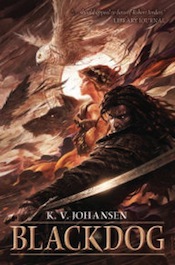 Every mountain, lake, and river has its own deity in K. V. Johansen’s Blackdog. Some are quite powerful and distant, some are mad, and others are like kindly village elders, keeping alive the oral history of the tribe and officiating at weddings. The lake goddess Attalissa is unique. She chooses to incarnate, being born as a baby and living a full life, then repeating the cycle again. When she is young, she is vulnerable, and so, long ago, she bound a dark spirit called the Blackdog to the life of a man. The Blackdog is her guardian and protector, and passes from man to man as each host dies. It is better when a host is willing, but not necessary. When unforeseen events force a very young incarnation to flee her temple, a rogue named Holla-Sayan becomes the newest host of the Blackdog. Holla-Sayan takes Attalissa back with him to the caravan roads, where he introduces her as… his illegitimate daughter! K. V. Johansen has done something I’ve never seen before—she’s told a coming-of-age tale about a goddess.
Every mountain, lake, and river has its own deity in K. V. Johansen’s Blackdog. Some are quite powerful and distant, some are mad, and others are like kindly village elders, keeping alive the oral history of the tribe and officiating at weddings. The lake goddess Attalissa is unique. She chooses to incarnate, being born as a baby and living a full life, then repeating the cycle again. When she is young, she is vulnerable, and so, long ago, she bound a dark spirit called the Blackdog to the life of a man. The Blackdog is her guardian and protector, and passes from man to man as each host dies. It is better when a host is willing, but not necessary. When unforeseen events force a very young incarnation to flee her temple, a rogue named Holla-Sayan becomes the newest host of the Blackdog. Holla-Sayan takes Attalissa back with him to the caravan roads, where he introduces her as… his illegitimate daughter! K. V. Johansen has done something I’ve never seen before—she’s told a coming-of-age tale about a goddess.
Top art by Michael Komarck for The Art of H.P. Lovecraft’s The Cthulhu Mythos
Lou Anders is the author of Frostborn, the first book in the Thrones & Bones middle-grade series, and its sequel, Nightborn. He likes reading and writing adventure stories and designing the board games that appear in the books (which you can play too!). You can learn more about him at louanders.com and more about the world of Thrones & Bones at thronesandbones.com.









